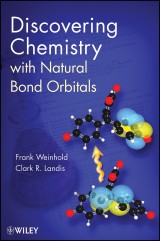Details

Discovering Chemistry With Natural Bond Orbitals
1. Aufl.
|
78,99 € |
|
| Verlag: | Wiley |
| Format: | EPUB |
| Veröffentl.: | 15.06.2012 |
| ISBN/EAN: | 9781118229194 |
| Sprache: | englisch |
| Anzahl Seiten: | 336 |
DRM-geschütztes eBook, Sie benötigen z.B. Adobe Digital Editions und eine Adobe ID zum Lesen.
Beschreibungen
This book explores chemical bonds, their intrinsic energies, and the corresponding dissociation energies which are relevant in reactivity problems. It offers the first book on conceptual quantum chemistry, a key area for understanding chemical principles and predicting chemical properties. It presents NBO mathematical algorithms embedded in a well-tested and widely used computer program (currently, NBO 5.9). While encouraging a "look under the hood" (Appendix A), this book mainly enables students to gain proficiency in using the NBO program to re-express complex wavefunctions in terms of intuitive chemical concepts and orbital imagery.<br /> <br />
Preface <p><b>1 Getting Started</b></p> <p>1.1 Talking to your electronic structure system</p> <p>1.2 Helpful tools</p> <p>1.3 General $NBO keylist usage</p> <p>1.4 Producing orbital imagery</p> <p><i>Problems and Exercises</i></p> <p><b>2 Electrons in Atoms</b></p> <p>2.1 Finding the electrons in atomic wavefunctions</p> <p>2.2 Atomic orbitals and their graphical representation</p> <p>2.3 Atomic electron configurations</p> <p>2.4 How to find electronic orbitals and configurations in NBO output</p> <p>2.5 Natural Atomic Orbitals and the Natural Minimal Basis</p> <p><i>Problems and Exercises</i></p> <p><b>3 Atoms in Molecules</b></p> <p>3.1 Atomic orbitals in molecules</p> <p>3.2 Atomic configurations and atomic charges in molecules</p> <p>3.3 Atoms in open-shell molecules</p> <p><i>Problems and Exercises</i></p> <p><b>4 Hybrids and Bonds in Molecules</b></p> <p>4.1 Bonds and lone pairs in molecules</p> <p>4.2 Atomic hybrids and bonding geometry</p> <p>4.3 Bond polarity, electronegativity, and Bent's rule</p> <p>4.4 Electron-deficient 3-center bonds</p> <p>4.5 Open-shell Lewis structures</p> <p>4.6 Lewis-like structures in transition metal bonding</p> <p><i>Problems and Exercises</i></p> <p><b>5 Resonance Delocalization Corrections</b></p> <p>5.1 The Natural Lewis Structure perturbative model</p> <p>5.2 2nd-order perturbative analysis of donor-acceptor interactions</p> <p>5.3 $DEL energetic analysis</p> <p>5.4 Delocalization tails of Natural Localized Molecular Orbitals</p> <p>5.5 How to $CHOOSE alternative Lewis structures</p> <p>5.6 Natural Resonance Theory</p> <p><i>Problems and Exercises</i></p> <p><b>6 Steric and Electrostatic Effects</b></p> <p><b>6.1 Nature and evaluation of steric interactions</b></p> <p><b>6.2 Electrostatic and dipolar analysis</b></p> <p><b><i>Problems and Exercises</i></b></p> <p><b>7 Nuclear and Electronic Spin Effects</b></p> <p>7.1 NMR chemical shielding analysis</p> <p>7.2 NMR J-coupling analysis</p> <p>7.3 ESR spin-density distribution</p> <p><i>Problems and Exercises</i></p> <p>8 Coordination and Hyperbonding</p> <p>8.1 Lewis acid-base complexes</p> <p>8.2 Transition metal coordinate bonding</p> <p>8.3 Three-center, four-electron hyperbonding</p> <p><i>Problems and Exercises</i></p> <p>9 Intermolecular Interactions</p> <p>9.1 Hydrogen-bonded complexes</p> <p>9.2 Other donor-acceptor complexes</p> <p>9.3 Natural energy decomposition analysis</p> <p><i>Problems and Exercises</i></p> <p>10 Transition State Species and Chemical Reactions</p> <p>10.1 Ambivalent Lewis structures: the transition-state limit</p> <p>10.2 Example: bimolecular formation of formaldehyde</p> <p>10.3 Example: unimolecular isomerization of formaldehyde</p> <p>10.4 Example: SN2 halide exchange reaction</p> <p><i>Problems and Exercises</i></p> <p>11 Excited State Chemistry</p> <p>11.1 Getting to the “root” of the problem</p> <p>11.2 Illustrative applications to NO excitations</p> <p>11.3 Finding common ground: state-to-state NBO transferability</p> <p>11.4 NBO/NRT description of excited state structure and reactivity</p> <p>11.5 Conical intersections and intersystem crossings</p> <p><i>Problems and Exercises</i></p> <p><b>Appendix A</b>: What's Under the Hood?</p> <p><b>Appendix B</b>: Orbital Graphics: The NBOView Orbital Plotter</p> <p><b>Appendix C</b>: Digging at the Details</p> <p><b>Appendix D</b>: What if Something Goes Wrong?</p> <p><b>Appendix E</b>: Atomic Units and Conversion Factors</p>
<p>“Following this text’s clear explanations, even readers with limited backgrounds in quantum mechanics will learn how to perform sophisticated explorations of modern bonding and valency concepts.” (<i>Chimie Nouvelle</i>, 1 March 2013)</p>
<p><b>FRANK WEINHOLD, PhD,</b> is Emeritus Professor of Physical and Theoretical Chemistry at the University of Wisconsin–Madison. Professor Weinhold has served on the editorial advisory boards of the International Journal of Quantum Chemistry and Russian Journal of Physical Chemistry. He is the author of more than 170 technical publications and software packages, including the natural bond orbital program.</p> <p><b>CLARK R. LANDIS, PhD,</b> is Professor of Inorganic Chemistry at the University of Wisconsin–Madison. He has received teaching and lectureship awards for his contributions to chemical education. Dr. Landis's research focuses on catalysis in transition metal complexes.</p>
<p><b>Learn how to investigate chemical bonding questions using modern NBO computational methods</b></p> <p>Using the latest computational technology, this practical how-to guide to chemical discovery introduces readers to natural bond orbital (NBO) concepts, strategies, and practical implementations. Without resorting to complex mathematics and programming, readers will learn how to fully leverage the NBO 5.9 computer program to re-express complex multi-electron wave functions in terms of intuitive chemical concepts and orbital imagery.</p> <p>Discovering Chemistry with Natural Bond Orbitals begins with an introductory chapter that sets forth the basics, including how to produce orbital imagery. Next, the authors cover such critical topics as:</p> <ul> <li>Electrons in atoms</li> <li>Hybrids and bonds in molecules</li> <li>Steric and electrostatic effects</li> <li>Atoms in molecules</li> <li>Resonance delocalization corrections</li> <li>Nuclear and electronic spin effects</li> </ul> <p>Each chapter ends with problems and exercises that enable readers to apply NBO methods to investigate chemical bonds, their intrinsic energies, and the corresponding dissociation energies that are relevant in reactivity problems. There are also worked-out examples and sample input and output throughout the text to help guide and support readers in their own investigations. In addition, the text features numerous sidebars and links to websites and other texts where more in-depth information can be found on individual topics.</p> <p>There are five appendices at the end of the text filled with useful supplementary material, including Appendix D, "What if Something Goes Wrong?", to help readers solve common problems that arise in NBO investigations.</p> <p>Following this text's clear explanations, even readers with limited backgrounds in quantum mechanics will learn how to perform sophisticated explorations of modern bonding and valency concepts.</p>


















